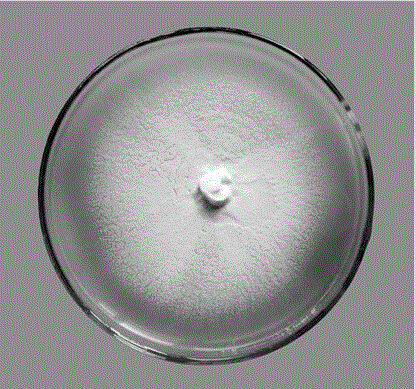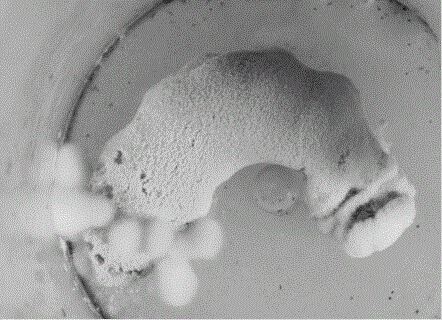Beauveria bassiana with high pathogenicity to anoplophora chinensis larva and applications thereof
A technology of Beauveria bassiana and Beauveria beauveria, which is applied in the application, pesticides, fungi and other directions, can solve the problems of serious harm, withering and loss of forestry production, and achieve strong secondary infection. ability, reducing the number of populations, and solving the effect of environmental pollution
- Summary
- Abstract
- Description
- Claims
- Application Information
AI Technical Summary
Problems solved by technology
Method used
Image
Examples
Embodiment 1
[0024] Identification of Beauveria bassiana FJBb201023
[0025] Morphological identification:
[0026] Cultivate the isolated and purified Beauveria bassiana strain on a flat PPDA medium with a diameter of 90mm at 25±1°C. After 4-5 days, pick a white hyphae preparation and observe the hyphae and distribution of the strain under a microscope. Morphology of sporozoites; 10-12 days later, pick mature conidia and make slices to observe the shape and size of conidia. Observe and record the morphological characteristics of the colony for about 15 days. The colony of this strain is white to milky white, and it is fluffy or cottony at first, and later forms a milk powder-like spore layer. The spore layer is thick and uniform, and the center is raised. Branched hyphae, regular, colorless and smooth, sometimes growing in clusters; sporogenous cells (bottle stems) are densely clustered on short and enlarged stalk cells, bottle-shaped, the upper part of the sporogenous cells is zigzag, ...
Embodiment 2
[0036] Biological Characteristics of Beauveria bassiana FJBb201023
[0037] The Beauveria bassiana strain FJBb201023 was inoculated in the center of the PPDA plate medium by the spot method, cultured in an incubator at 25±1°C, and the diameter of the colony was measured once a day by the cross method, and 3 colonies were set for each treatment Repeat for a total of 15 days of observation. At the same time, record the start time of sporulation. On the 15th day (sporulation is basically over), use a puncher with a diameter of 1.5 cm to punch a small plate from the center of the colony to the edge 1 / 2, take out the plate and place it in a 0.3 ‰ Tween-80 sterile water in the Erlenmeyer flask, shake to fully disperse the spores and properly dilute, measure the concentration of spores with a hemocytometer and convert it into the amount of sporulation per unit area. Three wells were drilled on each plate to measure the spore content, and the average value was taken as the number of ...
Embodiment 3
[0042] Determination of Pathogenicity of Beauveria bassiana FJBb201023 to Beauveria larvae
[0043] A certain amount of Beauveria bassiana (Beauveria bassiana) FJBb201023 spores were scraped from the PPDA plate and placed in sterilized 0.3‰ Tween-80 solution to prepare 10 7 Spores / mL of spore suspension (the suspension is Beauveria bassiana FJBb201023 inoculum); immerse healthy 3-instar longhorn beetle larvae in the spore suspension for 10 seconds, then put them back into the empty insect culture tube, and inoculate 30 long beetle larvae, repeated 3 times; treated with 0.3‰ Tween-80 sterile aqueous solution as a control. After the treatment, place the insect culture box in a dark 25±1°C constant temperature incubator, observe and record the death of the beetle larvae every day, and observe the growth of mycelia and sporulation of the dead insects in moisturizing culture (visible to the naked eye grows on the dead insects). hyphae and spores), and pick the slices under a micro...
PUM
 Login to View More
Login to View More Abstract
Description
Claims
Application Information
 Login to View More
Login to View More - R&D Engineer
- R&D Manager
- IP Professional
- Industry Leading Data Capabilities
- Powerful AI technology
- Patent DNA Extraction
Browse by: Latest US Patents, China's latest patents, Technical Efficacy Thesaurus, Application Domain, Technology Topic, Popular Technical Reports.
© 2024 PatSnap. All rights reserved.Legal|Privacy policy|Modern Slavery Act Transparency Statement|Sitemap|About US| Contact US: help@patsnap.com










